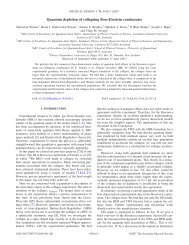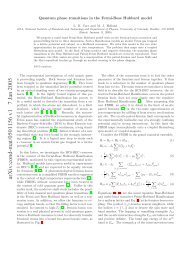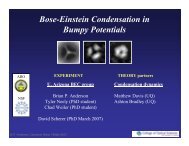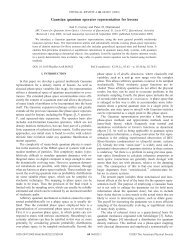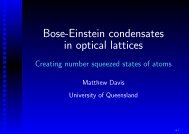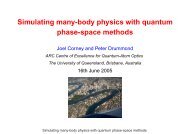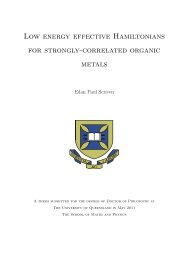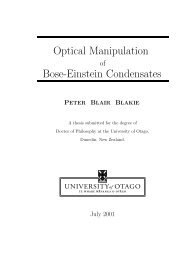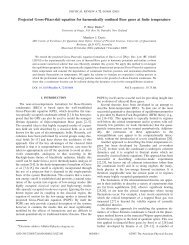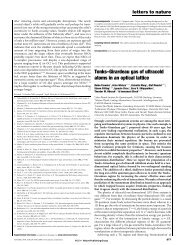7. <strong>Quantum</strong> simulations <strong>of</strong> evaporatively cooled <strong>Bose</strong> condensateslength scales. In fact the presence <strong>of</strong> interparticle interactions means that the atom densityshould be anticorrelated at short distances. There have been indirect local measurementsthat demonstrate the existence <strong>of</strong> some forms <strong>of</strong> higher-order coherence[18, 26, 84, 122],but a complete description or confirmation <strong>of</strong> all the coherence properties <strong>of</strong> the condensateis not yet available. Indeed, it has been pointed out[135] that these experiments donot measure the true second-order correlation function, and that anticorrelation effectsdue to interatomic repulsion extend over longer distances than the scattering length a 0 .Thus a lack <strong>of</strong> second-order coherence over short length scales should be measurable inthe laboratory.Possession <strong>of</strong> coherence implies the existence <strong>of</strong> a phase. Can a phase be ascribedto a condensate in isolation or only in relation to other condensates? Such issues wereaddressed in Ch. 3, in the context <strong>of</strong> measurements <strong>of</strong> relative phase. There it was shownthat even if a condensate in isolation was in a number state, interaction with a secondcondensate induced a relative phase, thus breaking the symmetry. In contrast, in othercondensed-matter systems, such as superfluids and superconductors, which contain manymore particles (by a factor <strong>of</strong> 10 20 or more), the symmetry-breaking processes occur duringthe formation <strong>of</strong> the order parameter when quantum fluctuations are important. Duringthe early stages <strong>of</strong> order-parameter formation, the condensed part <strong>of</strong> the system is smalland subject to quantum fluctuations. As <strong>Bose</strong> stimulation populates the condensate, thesefluctuations freeze out, to become macroscopic properties <strong>of</strong> an essentially classical system.In the case <strong>of</strong> condensates in atom traps, if and how the symmetry breaks during theformation remains an open question. Is there sufficient decoherence that the environmentcan couple to the condensate order parameter and break the symmetry, or are thesecondensates closer to number states, in which phase remains undetermined until an actualmeasurement or other intervention? This process <strong>of</strong> symmetry breaking has much widerimplications than for <strong>Bose</strong>-condensed systems; it aids the understanding <strong>of</strong> cosmologicalevolution and the formation <strong>of</strong> structure in the early universe[81, 104, 190, 191].To address important issues such as these about the nature <strong>of</strong> the condensate, a quantummechanical simulation <strong>of</strong> the evaporative cooling process that leads to condensationmust be undertaken. The final ground state <strong>of</strong> this many-body system is the result <strong>of</strong>a quantum dynamical process which is far from thermal equilibrium. This problem hasbeen approached by many authors using various approximate methods. But to provide a141
7. <strong>Quantum</strong> simulations <strong>of</strong> evaporatively cooled <strong>Bose</strong> condensatesbenchmark for these treatments, and to precisely determine coherence properties, all thequantum effects must be included without approximation.7.1.2 Evaporative coolingThe production <strong>of</strong> atomic <strong>Bose</strong> condensates in recent years has relied upon the development<strong>of</strong> efficient atom trapping and cooling techniques. In particular, it is the amazing success<strong>of</strong> evaporative cooling techniques that has enabled condensation in atom traps. Atomevaporation cools far below recoil limit <strong>of</strong> laser cooling and reduces the temperature bymany orders <strong>of</strong> magnitude without diluting the gas. In this process, the gas is loaded into amagnetic or magneto-optical trap, perhaps at first undergoing some laser cooling[145]. Thegas will approximately obey a <strong>Bose</strong>-<strong>Einstein</strong> distribution. Atoms in the high-temperaturetail <strong>of</strong> the distribution have enough energy to escape from the trap, and do so takingaway more than the average energy per atom. The remaining atoms rethermalise throughelastic interatomic collisions, thereby repopulating the upper levels. The temperature isthus lowered, and there is always a supply <strong>of</strong> hot atoms which can take away more energy.The evaporative cooling procedure was first developed to cool hydrogen atoms[41, 82]in attempts to produce <strong>Bose</strong> condensation, but was more successfully applied to alkalimetalgases[37, 103, 143], leading to condensation in rubidium ( 87 Rb)[3] sodium ( 23 Na)[35],and lithium ( 7 Na)[16]. These alkali gases have a larger effective scattering cross sectionfor elastic collisions and so rethermalise at the faster rate necessary to overcome atomloss processes, such as three-body recombination. Evaporative cooling is now a commonprocedure, with <strong>Bose</strong> condensates being produced in approximately twenty laboratoriesworldwide at the time <strong>of</strong> writing, mainly in 87 Rb and including one in hydrogen[59].This chapter presents the results <strong>of</strong> using phase-space methods to directly simulate thequantum dynamics <strong>of</strong> evaporatively cooled condensates. The method enables calculation<strong>of</strong> the time evolution <strong>of</strong> system properties. We will review the results for several physicalsituations, which reveal interesting transient behaviours and also evidence for the spontaneousformation <strong>of</strong> additional structures, including the evidence for vortices as reportedin [46]. This thesis does not attempt to provide conclusive answers to all the issues raisedabove or to completely characterise the condensate ground state, but rather it summarisesthe progress that has been made using phase-space techniques. These first attempts <strong>of</strong>such multimode quantum calculations constitute only the first steps <strong>of</strong> a comprehensive142
- Page 1 and 2:
Open Quantum Dynamics of Mesoscopic
- Page 3 and 4:
AcknowledgementsMy thanks must firs
- Page 5 and 6:
AbstractThe properties of an atomic
- Page 7 and 8:
CONTENTS4 Continuously monitored Bo
- Page 9 and 10:
List of Figures2.1 Two-mode approxi
- Page 11 and 12:
LIST OF FIGURES7.5 Angular momentum
- Page 14 and 15:
LIST OF ABBREVIATIONS AND SYMBOLSI{
- Page 17 and 18:
1. Condensation ‘without forces
- Page 19 and 20:
1. Condensation ‘without forces
- Page 21 and 22:
Chapter 2Properties of an atomic Bo
- Page 23 and 24:
2. Properties of an atomic Bose con
- Page 25 and 26:
2. Properties of an atomic Bose con
- Page 27 and 28:
2. Properties of an atomic Bose con
- Page 29 and 30:
2. Properties of an atomic Bose con
- Page 31 and 32:
2. Properties of an atomic Bose con
- Page 33 and 34:
2. Properties of an atomic Bose con
- Page 35 and 36:
2. Properties of an atomic Bose con
- Page 37 and 38:
2. Properties of an atomic Bose con
- Page 39 and 40:
2. Properties of an atomic Bose con
- Page 41 and 42:
2. Properties of an atomic Bose con
- Page 43 and 44:
2. Properties of an atomic Bose con
- Page 45 and 46:
2. Properties of an atomic Bose con
- Page 47 and 48:
2. Properties of an atomic Bose con
- Page 49 and 50:
2. Properties of an atomic Bose con
- Page 51 and 52:
2. Properties of an atomic Bose con
- Page 53 and 54:
2. Properties of an atomic Bose con
- Page 55 and 56:
2. Properties of an atomic Bose con
- Page 57 and 58:
2. Properties of an atomic Bose con
- Page 59 and 60:
2. Properties of an atomic Bose con
- Page 62 and 63:
3. Homodyne measurements on a Bose-
- Page 64 and 65:
3. Homodyne measurements on a Bose-
- Page 66 and 67:
3. Homodyne measurements on a Bose-
- Page 68 and 69:
3. Homodyne measurements on a Bose-
- Page 70:
3. Homodyne measurements on a Bose-
- Page 75 and 76:
3. Homodyne measurements on a Bose-
- Page 77 and 78:
3. Homodyne measurements on a Bose-
- Page 79 and 80:
Chapter 4Continuously monitored con
- Page 81 and 82:
4. Continuously monitored Bose cond
- Page 83 and 84:
4. Continuously monitored Bose cond
- Page 85 and 86:
4. Continuously monitored Bose cond
- Page 87 and 88:
4. Continuously monitored Bose cond
- Page 89 and 90:
4. Continuously monitored Bose cond
- Page 91 and 92: 4. Continuously monitored Bose cond
- Page 93 and 94: 4. Continuously monitored Bose cond
- Page 95 and 96: 4. Continuously monitored Bose cond
- Page 97 and 98: 4. Continuously monitored Bose cond
- Page 99 and 100: 4. Continuously monitored Bose cond
- Page 101 and 102: 4. Continuously monitored Bose cond
- Page 103 and 104: 4. Continuously monitored Bose cond
- Page 105 and 106: 4. Continuously monitored Bose cond
- Page 107 and 108: Chapter 5Weak force detection using
- Page 109 and 110: 5. Weak force detection using a dou
- Page 111 and 112: 5. Weak force detection using a dou
- Page 113 and 114: 5. Weak force detection using a dou
- Page 115 and 116: 5. Weak force detection using a dou
- Page 117 and 118: 5. Weak force detection using a dou
- Page 119 and 120: 5. Weak force detection using a dou
- Page 121 and 122: 5. Weak force detection using a dou
- Page 123 and 124: Part IIQuantum evolution of a Bose
- Page 125 and 126: 6. Quantum effects in optical fibre
- Page 127 and 128: 6. Quantum effects in optical fibre
- Page 129 and 130: 6. Quantum effects in optical fibre
- Page 131 and 132: 6. Quantum effects in optical fibre
- Page 133 and 134: 6. Quantum effects in optical fibre
- Page 135 and 136: 6. Quantum effects in optical fibre
- Page 137 and 138: 6. Quantum effects in optical fibre
- Page 139 and 140: 6. Quantum effects in optical fibre
- Page 141: Chapter 7Quantum simulations of eva
- Page 145 and 146: 7. Quantum simulations of evaporati
- Page 147 and 148: 7. Quantum simulations of evaporati
- Page 149 and 150: 7. Quantum simulations of evaporati
- Page 151 and 152: 7. Quantum simulations of evaporati
- Page 153 and 154: 7. Quantum simulations of evaporati
- Page 155 and 156: 7. Quantum simulations of evaporati
- Page 157 and 158: 7. Quantum simulations of evaporati
- Page 159 and 160: 7. Quantum simulations of evaporati
- Page 161 and 162: 7. Quantum simulations of evaporati
- Page 163 and 164: 7. Quantum simulations of evaporati
- Page 165 and 166: 7. Quantum simulations of evaporati
- Page 167 and 168: 7. Quantum simulations of evaporati
- Page 169 and 170: 7. Quantum simulations of evaporati
- Page 171 and 172: A. Stochastic calculus in outlineco
- Page 173 and 174: Appendix BQuasiprobability distribu
- Page 175 and 176: B. Quasiprobability distributions u
- Page 177 and 178: Bibliography[1] Agrawal, G. P. Nonl
- Page 179 and 180: BIBLIOGRAPHY[22] Carter,S.J.Quantum
- Page 181 and 182: BIBLIOGRAPHY[45] Drummond, P. D., C
- Page 183 and 184: BIBLIOGRAPHY[68] Gordon,D.,andSavag
- Page 185 and 186: BIBLIOGRAPHY[92] Jaksch,D.,Gardiner
- Page 187 and 188: BIBLIOGRAPHY[114] Marshall, R. J.,
- Page 189 and 190: BIBLIOGRAPHY[135] Naraschewski, M.,
- Page 191 and 192: BIBLIOGRAPHY[158] Shelby, R. M., Le
- Page 193 and 194:
BIBLIOGRAPHY[179] Wiseman, H. M. Qu
- Page 195:
. . . but this book is already too



